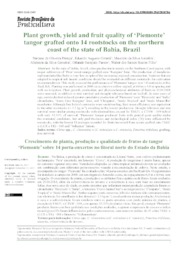Plant growth, yield and fruit quality of 'Piemonte' tangor grafted onto 14 rootstocks on the northern coast of the state of Bahia, Brazil.
Plant growth, yield and fruit quality of 'Piemonte' tangor grafted onto 14 rootstocks on the northern coast of the state of Bahia, Brazil.
Author(s): FRANÇA, N. de O.; GIRARDI, E. A.; AMORIM, M. da S.; GESTEIRA, A. da S.; PASSOS, O. S.; SOARES FILHO, W. dos S.
Summary: In the state of Bahia, Brazil, citrus production is mainly on the Northern Coast region, with major cultivation of ?Pera? sweet orange grafted onto ?Rangpur? lime. The production of mandarins and mandarin-like fruits is very low in spite of the increasing regional consumption. Varieties that are adapted to tropical sub humid conditions should be evaluated on different rootstocks for cultivation recommendation. This study assessed the performance of ?Piemonte? tangor over 14 rootstocks in Rio Real, BA. Planting was performed in 2006 on a cohesive yellow argisol, at 6.0 m x 4.0 m spacing and with no irrigation. Plant growth, production, and physicochemical attributes of fruits in 2010-2014 were assessed, in addition to tree survival and drought tolerance based on leafroll. At nine years of age, rootstocks that induced greater cumulative production of ?Piemonte? were ?Riverside? and ?Indio? citrandarins, ?Santa Cruz Rangpur? lime, and ?Cleopatra?, ?Sunki Tropical? and ?Sunki Maravilha? mandarins. Although four hybrid rootstocks were semidwarfing, their mean efficiency was equivalent to the other rootstocks (? 5.5 kg m-3), resulting in the lowest production. Drought tolerance and tree survival were similar among rootstocks with minimal loss, except for TSKFL x CTSW - 049 hybrid with only 33.33% of survival. ?Piemonte? tangor produced fruits with general good quality under the evaluated conditions, but only peel thickness and technological index (TI) were influenced by rootstocks, with the lowest TI averages recorded for fruits harvested from scions grafted onto TSKC x (LCR x TR) - 001 and ?Volkamer? lemon.
Publication year: 2018
Types of publication: Journal article
Unit: Embrapa Cassava & Fruits
Keywords: Fruta Cítrica, Poncirus Trifoliata
Observation
Some of Embrapa's publications are published as ePub files. To read them, use or download one of the following free software options to your computer or mobile device. Android: Google Play Books; IOS: iBooks; Windows and Linux: Calibre.
Access other publications
Access the Agricultural Research Database (BDPA) to consult Embrapa's full library collection and records.
Visit Embrapa Bookstore to purchase books and other publications sold by Embrapa.

